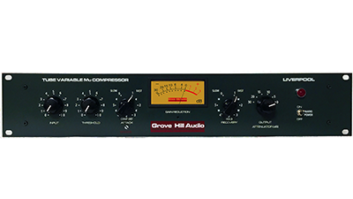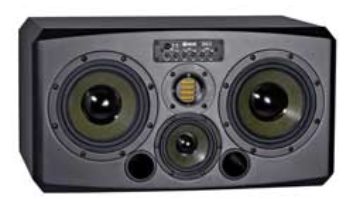
Fostex has been doing this pro audio thing for a long while now. My own experience with the company goes back many years and brings back great memories of my Fostex R8 reel-to-reel multitrack. However, the company’s reach has at one time or another extended into nearly every product category you can think of, including many different studio monitors and personal monitoring systems that go back for decades. The new PX-6 is a big step up and a move forward for Fostex’s studio monitor line.
Let’s Take a Look
The PX-6 is made up of a 6.5-inch Crimson woofer and 1-inch polyester-fiber dome tweeter. The cabinet looks clean and feels solidly built. It weighs 15.5 pounds and measures 13.2×8.2×10 inches (HxWxD), with a pair of tuned ports on the front that are said to help deliver a frequency response below the rated range of 48 Hz to 20 kHz. The speakers are driven by a pair of digital amplifiers rated at 50 watts for the woofer, 28W for the tweeter. The published signal-to-noise rating is 96 dB; I found them to run very quietly.
Around back is an XLR/ ¼-inch female combo input jack. A balanced connection is ported through the XLR, while the ¼-inch and a separate female RCA connection are unbalanced. The XLR input can handle line level up to +24dBu, and the unbalanced connections allow for +10dBu inputs.
The controls on the back comprise a single selector switch and encoder knob. These two allow a range of settings, including: volume, HF boost/cut, LF roll-off, the HPF for use with a subwoofer, adjustment of phase, and the ability to save the settings once you are done. You can also engage or disable the Auto Standby function for power saving.
In Studio
I set up the PX-6s in the control room at Eclectica Studios, where the playback system comprises a Sequoia DAW digitally connected to a Mytek Stereo192DSD D/A converter via a RME HDSP9652. The speakers were placed on isolated stands with time and care taken to align them optimally. (Note: The illuminated controls on the back of the unit must be seen to be adjusted.)
The manual does a good job of describing how to properly set up the PX-6’s EQ and phase settings. The selector switch changes the Encoder’s assignment from Volume to Tone (EQ). When Volume is assigned to the knob, it adjusts the overall volume. Press the Encoder once and the knob changes to now adjust the volume in fine increments. Indicator lights under the Encoder tell you which setting the encoder is currently adjusting. Moving the selector switch to Tone allows you to adjust the treble with the choices of remaining flat or boosting or cutting by 3 dB. Clicking the Encoder again will bring up bass roll-off, and then you may also click and hold the Encoder down for 3 seconds to engage the preset 85Hz, 36dB/octave highpass filter.
There is also an option for adjusting the phase of the speaker for proper alignment with a subwoofer. Settings are in 9-degree increments from 0 to 180 degrees. Using the Encoder and indicator lights does have a learning curve but nets a good result, and once you are dialed in, you can save the settings.
In the Ear
I first set up the PX-6s with a Mackie MR3Smk3 subwoofer. Setting up the crossover and phase went smoothly and sounded very good. After aligning the speakers and settling down, the first thing I listened for was stereo imaging. The PX-6 reproduces the soundscape very well. I was very impressed—they appeared equal to my Neumann KH120s in this regard, which is something I rarely find.
I used the PX-6 for more than a month. The high-end definition was clear and accurate and my mixes translated well to other systems. I did find them to be harsh at high volume at the same range listed as the internal crossover, and they are a little less powerful compared to what I am used to, so I may be getting to the top of their range. In normal mixing situations, I had no issue with this harshness and was able to EQ and reference frequencies as expected.
In using the PX-6 without the sub, I experienced bass that extended low enough to be very usable on its own. Running test tones through the PX-6, I was still getting a good low-end response down into the 34Hz range. These speakers really shine on their own, and I enjoyed them more without a sub, something I am not used to saying about a pair of 6.5-inch monitors.
The power rating of the PX-6 states a 50/ 28-watt amplifier, but for me they seemed slightly underpowered—again, not a deal breaker because of their overall tone and response. For composing, editing, mixing and post work, the PX-6 would have more than enough power.
The last thing I did was take the PX-6s into our live room and set them up in a not so proper fashion: one speaker on a Marshall 4×12 and the other on a taller stack of flight cases. I plugged my smart phone into them by way of their RCA jacks and listened to various artists while walking around the room. I was pleasantly surprised that while many near-field monitors sound boxy and completely unable to cope with such a hostile scenario, the PX-6 sounded great.
How Was It?
The specs talk about many things such as having a “Digital Network Filter (FIR type) dividing network resulting in very accurate time alignment to deliver supreme sound positioning.” To be honest I have no idea what that means beyond the time alignment, but I do know that the development that went into the PX-6s allowed for higher-than-average stereo image reproduction, a very good frequency response and a good overall experience.
The PX-6s are good-sounding speakers—transients were delivered and instruments were reproduced how I am used to hearing them. The extended low-end response, clear highs and stereo image were all very good. I know the market is crowded, but if you are in the market to upgrade your current setup or need to outfit a new room, the PX-6s are worthy of a listen.
Product Summary
COMPANY: Fostex
PRODUCT: PX-6
WEBSITE: www.fostex.com/usa
PRICE: $999/pair
PROS: Stereo imaging. Ability to deal with unforgiving environments.
CONS: Controls on back must be seen to adjust. Limited EQ adjustment. Felt underpowered.
Tim Dolbear is an audio engineer and producer at Eclectica Studios in Austin, Texas. Connect at www.timdolbear.com.





